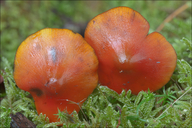date of photo Oct 21, 2016
latitude 46.35788 longitude 13.70155
View on Google Maps.
location
Lower Trenta valley, between villages Soča and Trenta, right bank of river Soča, above regional road Bovec- Vršič near Matevž farm house, Trenta 1, East Julian Alps (Posočje, Slovenia)notes Slo.: Konradova vlažnicaSlo.: Konradova vlažnica - syn.: Hygrocybe konradii R. Haller Aar. , Hygrocybe konradii var. pseudopersistens Bon, Hygrophorus acutoconicus f. japonicus Hongo, Hygrophorus subglobisporus P.D. Orton, Hygrocybe persistens var. konradii (R. Haller Aar.) Boertm. - Habitat: in light mixed wood, close to its edge, Fagus sylvatica, Picea abies, Ostrya carpinifolia dominant trees; moderately inclined mountain slope, south aspect; skeletal, colluvial, calcareous ground; mostly in shade; relatively warm and dry place; partly protected from direct rain by tree canopies; average precipitations ~ 3.000 mm/year, average temperature 7-9 deg C, elevation 555 m (1.820 feet), alpine phytogeographical region. Substratum: soil. Comments: First I thought I found another Hygrocybe conica which is frequent in Trenta valley. However, genus Hygrocybe and particularly H. conica (agg.) is difficult for determination. Taxonomy described by different authors differs widely. I keep with Boertmann (Ref.7). Species H. acutoconica differs from members of H. conica agg. by absence of fast and deep blackening of fruitbodies during handling and in time. Pilei photographed didn't blacken (or at least evidently much less than H. conica). H. acutoconica var. acutoconica has predominantly cylindrical, oblong and occasionally slightly constricted spores, which are. 5 - 6.5 microns wide (from 2-sterigmata basidia). Measured spores were evidently different - broadly elliptical, some elliptical and some subglobose. Their width was 7.4-7.9 microns (only 2-sterigmata basidia observed). Such spores correspond to Hygrocybe acutoconica var. konradii. According to Boertmann (2010) H. acutoconica var. acutoconica and H. acutoconica var. konradii are very similar and can be separated only by spore dimensions and shape. Pilei color og this find is unusual. It should 'normally' be yellow to reddish-yellow, however, Boertmann (2001) exceptionally allows also '... even entirely reddish'. Two fruitbodies present; pilei diameter 35 and 32 mm (measured as is, not expanded), slightly viscid; stems 67 and 72 mm long, 6 and 7 mm in diameters, slightly viscid, with small diameter hollow central channel, fibrous; taste and smell indistinctive; not bruising black when handling, only after long time becoming somewhat darker and duller; SP abundant, whitish-yellowish, oac 899. Spores smooth. Dimensions: 9,6 [10,9 ; 11,4] 12,7 x 6,3 [7,4 ; 7,9] 8,9 microns; Q = 1,3 [1,4 ; 1,5] 1,7; N = 31; C = 95%; Me = 11,1 x 7,6 microns; Qe = 1,5. Gill's trama regular, All observed basidia 2-spored. Dimensions: 19.4 [24.6 ; 27.7] 33 x 5.3 [6.9 ; 7.9] 9.5 microns; Q = 2.6 [3.4 ; 3.8] 4.5; N = 19; C = 95%; Me = 26.2 x 7.4 microns; Qe = 3.6. Olympus CH20, NEA 100x/1.25, magnification 1.000 x, oil (spores); NEA 40x/0.65, magnification 400x (basidia), NEA 10x/0.25, magnification 100x (gill's trama), fresh material, in water. AmScope MA500 digital camera. Herbarium: Mycotheca and lichen herbarium (LJU-Li) of Slovenian Forestry Institute, Večna pot 2, Ljubljana, Index Herbariorum LJF Ref.: (1) Personal communication with Mr. Andrej Piltaver, Institute for Systematic of Higher Fungi, Ljubljana. (2) J. Breitenbach, F. Kraenzlin, Eds., Fungi of Switzerland, Vol.3. Verlag Mykologia (1991), p 114. 3) E. Arnolds, Tribus Hygrocybeae in Bas et al. Flora Agaricina Neerlandica, Brookfield, Vol 2. (1990), pp70-111. 4) G.J. Krieglsteiner (Hrsg.), Die Grosspilze Baden-Württembergs, Band 3., Ulmer (2001), p 51. 5) A. Poler, Veselo po gobe, Mohorjeva družba Celovec (2002) (in Slovenian), p 332. (6) D. Arora, Mushrooms Demystified, Ten Speed Press, Berkeley (1986), p 115. (7) D. Boertmann, Hygrocybe, 2nd Rev., Svampetryk (2010), p 165. (8) S. Buczacki, Collins Fungi Guide, Collins (2012), p 266. (9) R. Phillips, Mushrooms, Macmillan (2006), p 76. Nikon D700/Nikkor Micro 105mm/f2.8camera Nikon D700/Nikkor Micro 105mm/f2.8
contributor's ID # Bot_1021/2016_DSC5962 photo category: Fungi - fungi
|
